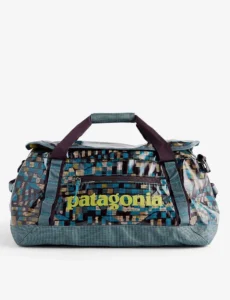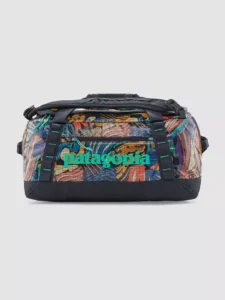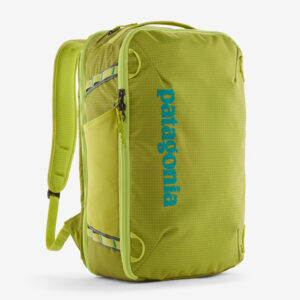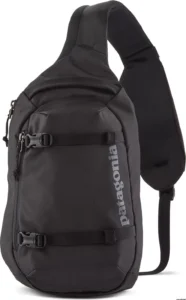Patagonia Bag embody the spirit of adventure and sustainability. Designed for those who appreciate both rugged durability and environmental responsibility, these bags are crafted using recycled materials like nylon and polyester. Patagonia bags cater to diverse needs, from backpacks equipped for hiking trails to versatile duffels for travel. Each bag reflects Patagonia’s commitment to minimizing environmental impact without compromising on quality or style. Whether exploring remote landscapes or navigating city streets, Patagonia bags are trusted companions that combine functionality with a conscientious approach to the planet.
Table of Content:-
- History of Patagonia Bag’s
- Designer Insight for Patagonia Bag
- Collection Overview towards this Patagonia Bag’s
- Materials Used in Assembling of Patagonia Bags
- Design Features of Patagonia Bags
- Care and Maintenance of this Patagonia Bags
- Styling Tips for Patagonia Bags

patagonia-bag
History of Patagonia Bag’s
Evolution of Patagonia Bags:
Start with Necessity
Patagonia bags began in the 1970s when climbers needed durable gear for harsh terrains. Yvon Chouinard, founder of Patagonia, started by making sturdy equipment for climbers.
Focus on Sustainability
Over time, Patagonia shifted focus to sustainability. They used recycled materials and promoted fair labor practices, setting a trend in eco-friendly outdoor gear.
Innovation and Expansion
Patagonia bags evolved with innovative designs and versatile uses, appealing to a broader audience beyond climbers. They became symbols of outdoor adventure and environmental responsibility.
Origin of Patagonia Bags:
Inspired by Nature
Patagonia bags draw inspiration from the rugged landscapes of Patagonia, South America. The region’s challenging environment influenced the need for tough, reliable gear.
Craftsmanship and Quality
Initially handmade, these bags reflected craftsmanship and attention to detail. Each design aimed for practicality and durability.
Cultural Impact
Patagonia bags became iconic due to their association with outdoor exploration and environmental ethics. They embody a lifestyle that values nature and adventure.

patagonia-bag
Designer Insight for Patagonia Bag
Functionality Driven
Patagonia bag designers prioritize functionality above all else. Every feature, from pockets to straps, is carefully considered to enhance usability in outdoor environments. They focus on making gear that is practical and reliable, whether for hiking, camping, or daily use.
Sustainable Materials
Sustainability is a core principle in Patagonia’s design philosophy. Designers select materials that minimize environmental impact, such as recycled polyester and organic cotton. They aim to reduce waste and promote eco-friendly practices throughout the production process.
Durability Standards
Patagonia bags are built to last. Designers conduct rigorous testing to ensure their products can withstand tough conditions and frequent use. They prioritize durability to minimize the need for replacements, aligning with Patagonia’s commitment to sustainability.
Aesthetic and Ethical Choices
Designers blend functionality with aesthetic appeal, creating bags that are not only practical but also visually appealing. They incorporate elements of outdoor-inspired design while adhering to ethical sourcing and manufacturing practices, reflecting Patagonia’s values of environmental and social responsibility.
Collection Overview towards this Patagonia Bag’s
Variety of Styles
Patagonia offers a diverse range of bags catering to different activities and preferences. From backpacks and duffels to sling packs and tote bags, each style is designed with specific functionalities in mind.
Materials and Sustainability
The collection emphasizes sustainable materials such as recycled polyester, organic cotton, and reclaimed nylon. These choices reflect Patagonia’s commitment to reducing environmental impact while maintaining durability and performance.
Performance Features
Each bag is equipped with performance-driven features like water-resistant coatings, ergonomic designs, and ample storage compartments. These elements ensure practicality and functionality in various outdoor and urban settings.
Innovative Designs
Patagonia continually innovates its bag designs, integrating new technologies and materials to enhance performance and comfort. Features like adjustable straps, ventilated back panels, and specialized compartments for electronics demonstrate their dedication to user-centric design.
Ethical Manufacturing
Patagonia prioritizes ethical manufacturing practices, ensuring fair labor conditions and supporting communities where their bags are made. This ethical approach extends to their supply chain, promoting transparency and accountability.
Seasonal Collections
The collection evolves with seasonal updates, introducing new colors, patterns, and limited-edition collaborations. This keeps the offerings fresh and aligns with trends while maintaining the brand’s core values.
Unique and Adaptability
Patagonia bags are versatile, suitable for diverse activities from hiking and camping to daily commutes and travel. This unique style enhances their appeal, making them ideal companions for both outdoor adventures and everyday use.
Environmental Impact
Throughout the collection, Patagonia educates consumers about the environmental impact of their products and encourages responsible consumption practices. This educational aspect complements their commitment to sustainability and fosters a community of environmentally conscious consumers.

patagonia-bag

patagonia-bag
Materials Used in Assembling of Patagonia Bags
Recycled Polyester
Patagonia bags often use recycled polyester, which is made from post-consumer plastic bottles or discarded polyester fabric. By recycling these materials, Patagonia reduces waste and lessens the environmental impact of production. Recycled polyester retains the durability and performance qualities of virgin polyester, making it ideal for creating tough, long-lasting bags.
Organic Cotton
Some components of Patagonia bags, such as linings or straps, may be made from organic cotton. Organic cotton is grown without synthetic pesticides or fertilizers, promoting healthier soil and waterways. Patagonia supports organic cotton farming to minimize environmental harm and ensure sustainable agriculture practices.
Nylon Ripstop
Nylon ripstop is a durable fabric used in Patagonia bags for its strength and resistance to tearing. It is woven with a special reinforcement technique that prevents tears and rips from spreading, enhancing the longevity of the bags. This material is commonly used in areas of the bag that require extra durability, such as bottoms, straps, and high-stress zones.
Reclaimed Nylon
In some collections, Patagonia incorporates reclaimed nylon sourced from post-industrial waste or discarded fishing nets. Reclaiming nylon reduces waste in oceans and landfills while offering a strong and versatile material for bag construction. This initiative supports efforts to clean up marine environments and promotes circular economy principles within the textile industry.
Design Features of Patagonia Bag
Functional Pockets and Compartments
Patagonia bags are designed with multiple pockets and compartments that serve specific purposes. These compartments are strategically placed to offer easy access to essentials like water bottles, phones, and snacks. They help keep belongings organized during outdoor activities or daily commutes, ensuring convenience and efficiency.
Adjustable Straps and Ergonomic Designs
Patagonia bags feature adjustable straps and ergonomic designs to enhance comfort and usability. Adjustable straps allow users to customize the fit for different activities or body types, reducing strain on shoulders and back. Ergonomic designs consider how the bag contours to the body, promoting natural movement and reducing discomfort during prolonged wear.
Water-Resistant and Weatherproof Materials
Many Patagonia bags utilize water-resistant and weatherproof materials to protect belongings from rain, snow, and moisture. These materials typically include coatings or treatments that repel water, keeping contents dry in unpredictable weather conditions. This feature is particularly important for outdoor enthusiasts who need reliable gear that can withstand various elements.
Durability and Reinforced Construction
The construction ensures the bags can withstand rugged outdoor environments and frequent use without compromising performance or longevity. Users can rely on Patagonia bags to endure adventures and daily activities with minimal wear and tear, making them a trusted choice for durability.
Care and Maintenance of this Patagonia Bag
Regular Cleaning
To maintain your Patagonia bag, regularly clean it using mild soap and water. Gently scrub any stains or dirt with a soft brush or sponge. Rinse thoroughly and air dry away from direct sunlight.
Storage
Store your Patagonia bag in a cool, dry place when not in use. Avoid prolonged exposure to sunlight or heat, as this can cause colors to fade and materials to degrade over time. Proper storage helps retain the bag’s shape and integrity.
Waterproofing
If your bag loses its water-resistant properties over time, reapply a DWR (Durable Water Repellent) treatment. Follow the manufacturer’s instructions for the specific product you use. This helps maintain the bag’s ability to repel water and protect your belongings.
Repair and Maintenance
Address any minor repairs promptly to prevent damage from worsening. Patagonia offers repair services for their products, including stitching repairs or replacing worn-out parts like zippers or straps. Utilize these services to extend the lifespan of your bag and reduce waste.
By following these care and maintenance tips, you can ensure your Patagonia bag remains in good condition for years of reliable use, whether for outdoor adventures or daily activities. Regular upkeep preserves the bag’s functionality and appearance, reflecting Patagonia’s commitment to durability and sustainability.
Styling Tips for Patagonia Bag
Casual Outfits
Pair your Patagonia bag with casual outfits like jeans, t-shirts, and sneakers for a laid-back, everyday look. The versatility of Patagonia bags makes them perfect for running errands or hanging out with friends.
Outdoor Adventures
When heading outdoors, choose a Patagonia bag that suits your activity—whether hiking, camping, or biking. Opt for earthy tones or camouflage patterns to blend with nature while ensuring functionality with multiple compartments for gear.
Travel Companion
Use a Patagonia backpack or duffel bag for travel. They offer ample storage and organization features for essentials like clothes, toiletries, and electronics. Choose neutral colors for versatility and easy coordination with different outfits.
Layered Look
Incorporate your Patagonia bag into a layered outfit during colder months. Pair it with a jacket, scarf, and boots for added warmth and style. The bag can complement the rugged aesthetic of outdoor-inspired clothing.
Beach Day
For beach outings, choose a Patagonia tote or backpack made from water-resistant materials. Pack sunscreen, towels, and snacks while maintaining a casual beach vibe. Bright colors or vibrant prints can add a fun, summery touch to your beach ensemble.

patagonia-bag
Frequently Asked Questions :-
Are Patagonia bags waterproof?
Many Patagonia bags are water-resistant, meaning they can repel light rain and moisture. For heavy rain or extended exposure to water, consider using a rain cover or reapplying a waterproofing treatment.
How do I clean my Patagonia bag?
Clean your Patagonia bag with mild soap and water. Gently scrub any stains and rinse thoroughly. Air dry away from direct sunlight to maintain its shape and color.
Can I repair my Patagonia bag if it gets damaged?
Yes, Patagonia offers repair services for their products. You can send your bag in for stitching repairs or replacing worn-out parts like zippers or straps. It’s a sustainable way to extend the life of your bag.
Are Patagonia bags suitable for everyday use?
Absolutely! Patagonia bags are designed for both outdoor adventures and daily activities. They come in various styles and sizes, from backpacks to tote bags, offering versatility and functionality for everyday needs.
Conclusion
Patagonia bags stand out not just for their rugged durability but also for their commitment to sustainability. Made from recycled materials like polyester and reclaimed nylon, they minimize environmental impact without compromising quality. Their water-resistant properties and sturdy construction ensure reliability in various weather conditions. Beyond utility, Patagonia promotes ethical practices, offering repair services to extend the lifespan of their products. Choosing a Patagonia bag means choosing gear that supports both your adventures and the planet, reflecting a dedication to responsible consumerism and outdoor exploration.
source by:- https://images.app.goo.gl/Zh1CWEF7aGe5Yi7W7
https://images.app.goo.gl/pKC8BSowHujQYNbG6
https://images.app.goo.gl/t8XjKg4NwNxM4N41A
https://images.app.goo.gl/PPLZF2mSTTp7VXDC7
https://images.app.goo.gl/TiqrYktqbiXUimx18
written by :-https://bioleather.in /
